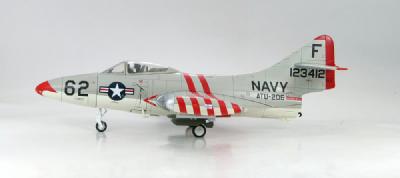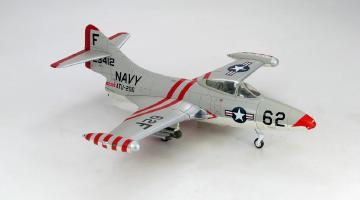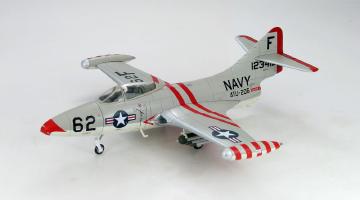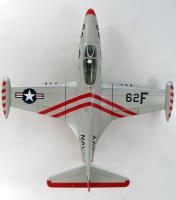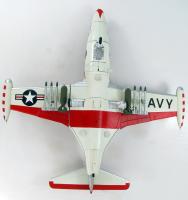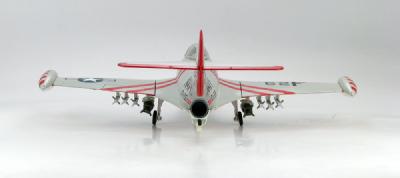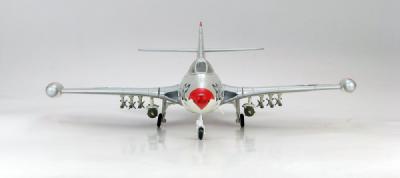Hobby Master Archive
Air Power Jets 1/48
F9F Panther
Grumman F9F-2 Panther ATU-206 (Advanced Training Unit) NAS Pensacola Forida 1956
The F9F Panther entered service in 1949. It was the first Grumman jet fighter, first Carrier- Borne Navy jet fighter in combat, first USN jet to shoot down an enemy airplane, first jet aircraft used by the Blue Angels. A total of 1,382 F9Fs were made. VF-781 was the first squadron to volunteer for combat in Korea and were 100% volunteers earning them the name “Pacemakers”. Ironically the USSR was making the same engine under license from Rolls-Royce for their Mig-15 that would be one of the F9F’s main Korean adversaries. The F9F flew 78,000 sorties with VF-781 flying 2,721 of them without a single loss of life. The US Marines flew the Panther until 1957 with some Reserve Units continuing to fly them a few years longer. Some aircraft were used for advanced pilot training and some became drones.
In 1825 the US Government realized the importance of Pensacola’s location and the vast timber supply available in the region. The President ordered a Navy yard be built on the spot where NAS Pensacola is located today. Over the years the base was destroyed and rebuilt only to be destroyed again or abandoned. These things came about during the American Civil War, a hurricane and tidal wave and an outbreak of yellow fever. In 1911 with the first successful landing of an airplane on a ship and the later development of a mechanism to catapult launch an airplane the US Navy realized the potential of the airplane and in 1914 ordered the creation of the first Naval Air Station at Pensacola. Naval Air Station (NAS) Pensacola, known as the “Cradle of Naval Aviation” has been responsible for training thousands of aviators for WWI, WWII, Korea and Vietnam. It was through these training units located at Pensacola and elsewhere that pilots learned more about aircraft and the weapons available to them. The Gulf of Mexico provided a large area for weapons testing. Most of the aircraft used here were outdated as far as front line service was concerned but still provided valuable training.
Specification for the Grumman F9F-2 Panther Engine: 1 X Pratt & Whitney J42-P-6/P-8 turbojet Rated at - 5,000 lb.s.t. for takeoff dry 5,950 lb.s.t. for takeoff with water injection Performance: Maximum speed - 575 mph at sea level, 545 mph at 22,000 feet, 529 mph at 3,500 feet Cruising speed - 487 mph Landing speed - 105 mph Initial climb rate - 5,140 feet per minute Service ceiling - 44,600 feet Normal range - 1,353 miles Dimensions: Wingspan - 38 feet 0 inches Length - 37 feet 5 3/8 inches Height - 11 feet 4 inches Wing area - 250 square feet.
Weights: Empty - 9,303 pounds Combat - 14,235 pounds Gross - 16,450 pounds Take-off - 19,494 pounds maximum Internal fuel capacity: 923 US gallons Armament: 4 X 20-mm cannon. Under-wing loads of up to 2,000 pounds of bombs and rockets could be carried on eight under-wing racks.
Pensacola Has A Haunting History An aura of mystery and splendor pervades “Admiral’s Row.” Significant on Johnson Street is Quarters “A,” a stately home where the air station’s most senior officer, the Chief of Naval Education and Training, and family reside. When this area was built in 1874, the Commandant of the old Navy Yard lived here. Now, for a haunting good yarn to spellbind you, and former Quarters “A,” residents say it is true!
As the story goes, Commodore Melanchton B. Woolsey was the first commandant to live here. He was terrified of contracting yellow fever, since an epidemic had already claimed thousands of lives and he didn’t want to be the disease’s next victim. He erroneously believed as others did also, that disease-carrying mosquitoes could only fly a few feet high. So, Woolsey moved into the third story cupola. He got his meals, rum (which he claimed was a “tonic” against the fever), and tobacco for his pipe by lowering a basket on a rope from one of the cupola’s windows. One day his servant forgot the rum! Woolsey died soon thereafter. Yet, as residents know, his spirit stayed on in the house. Perhaps to stay with a lovely lady, transparent and clad in white, who also resides in Quarters “A”, forever.
Building 16 Building 16 is another certified haunted place. This octagonal-shaped building was the Officers’ Quarters during the 1920s, and today, some say the building is haunted by a patron of that decade. In 1924, Marine Captain Guy Hall, a flight instructor, enjoyed playing poker when he wasn’t flying. While playing, he had a habit of picking up his poker chips, then letting them fall to the table. Hall died during a training mission in the 1920s, and on more than one occasion since that fateful day, people in building 16 have heard what sounds like poker chips hitting the table. How about a friendly game of poker in building 16?
Hobby Master 1/48 Air Power Series HA7203 Grumman F9F-2 Panther ATU-206 (Advanced Training Unit) NAS Pensacola, Florida, 1956 LIMITED EDITION with certificate
1/48 scale Professionally painted.
Die-cast metal with a minimum of plastic.
All markings pad applied for superb results.
Cockpit slides open.
Pilot figure.
Comes with display stand.
Landing gear is fully retractable and can be displayed up or down.
Wings can fold and unfold.
Extremely sought after by collectors.
THESE ARE PRE-PRODUCTION PICTURES NOT THE FINISHED MODEL
| Added to archive | 2015-11-19 |
| Last modified | 2015-11-19 |
| Leaflet | 2008-07-01 July 2008 |

